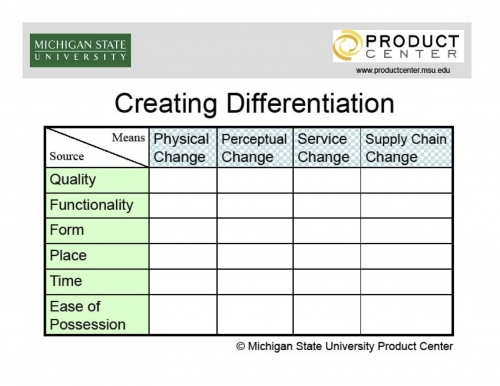Differentiation can add value to your products
Understanding differentiation can increase profits and market share for products and services
In his book, Competitive Advantage, Michael Porter said, “a firm can differentiate itself from its competitors when it provides something unique that is valuable to the buyers beyond simply offering a low price. Differentiation allows the firm to command a premium price, to sell more of its product at a given price, or to gain equivalent benefits such as greater buyer loyalty during cyclical or seasonal downturns.”
The same is true of a product. The Michigan State University Product Center has developed its Creating Differentiation chart to allow its clients to judge how much their product is differentiated from their competitors’ products. The more boxes that can be checked, the more differentiated the product and the more likely it is to be successful.
There are means and sources of creating differentiation.
The means of creating differentiation focus on the product. This includes making physical, perceptual, service and supply chain changes. One change might incorporate multiple means of differentiation. For example, adding packaging to a produce product might cause a physical change of the product. It might also give the perception that the product is more upscale or sophisticated. If it makes the product more convenient to use (such as ready to eat) it can also be a service change. If the packaging changes the place where a product is offered for sale, such as adding convenience stores as outlets for a product that was only available in the produce section of a supermarket, it can also be a supply chain change.
Other means of creating differentiation might include processing (including minimal processing such as fresh cut), cleaning, sorting, drying, delivery, canning, freezing, and many more.
The sources of creating differentiation focus on customers’ needs and desires. This includes quality, functionality, form, place, time and ease of possession. The packaging we discussed under means of differentiation might improve the quality of the produce, especially if it increases the shelf life (which might also affect the time when a product can be purchased). Ready-to-eat preparation and packaging affect the functionality of the produce. The packaging might mean that the product is available as a grab-and-go item in a convenience store, affecting both place and the ease of possession.
Other sources of creating differentiation might include selling on the internet, accepting credit cards, accepting EBT payments, using hoop houses to extend the production season to be both earlier and later than conventional production, being GAP (Good Agriculture Practices) certified, changing graphics to communicate higher quality or elegance, MAEAP (Michigan Agriculture Environmental Assurance Program) verification to communicate that the products are raised in an environmentally friendly manner, and many more.
Clients of the MSU Product Center are encouraged to carefully analyze their product or service using the Differentiation Chart to determine how differentiated their concept is from others available in the marketplace. The more boxes checked, the more differentiated the product and the more likely they will achieve success. After all, if you are just creating a “me too” product that is the same as everything else out there, the only way you can differentiate yourself is to lower the price. Our goal is to identify customer needs and create a product or service to meet those needs that will demand a premium in the marketplace and more profits for our clients.
The Michigan State University Product Center can assist people interested in exploring the development of value added, differentiated products.



 Print
Print Email
Email


